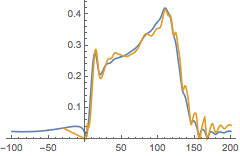![]() >
> ![]()
| WAVEFORMS TUTORIAL |
Gravitational Waves
SimulationTools has a large set of functionality for working with numerical time-series waveforms such as one would obtain by extracting gravitational radiation from a numerical relativity simulation.
Reading and exporting waveforms
SimulationTools supports a plug-in interface for reading waveform data. The format of choice is HDF5 data using the naming conventions of the Multipole Cactus thorn which is included with the Einstein Toolkit. There is also support for reading waveforms as ASCII data produced by the Multipole thorn and for reading waveforms in the NRDF format [http://arxiv.org/abs/0709.0093].
Reading data in Multipole format
| ReadPsi4 | ReadPsi4Modes | ReadPsi4Radii |
| $MultipolePsi4Variable |
Reading data produced using the Multipole Cactus thorn.
Read in the (2,2) mode of the gravitational waveform from a binary black hole merger, represented by ![]() extracted at a radius of 100M
extracted at a radius of 100M
In[1]:=
![]()
In[4]:=
![]()
Out[4]=
![]()
It is possible to specify the name of the output file produced by the Multipole thorn using the Multipole::variables parameter in the simulation parameter file, e.g.
Multipole::variables = “WeylScal4::Psi4r{sw=-2 cmplx=’WeylScal4::Psi4i’ name=’psi4’}”
By default, it is assumed that the name ‘psi4’ is used. This may be changed by setting $MultipolePsi4Variable
In[5]:=
![]()
In[6]:=
![]()
Out[6]=
![]()
Waveforms can be produced for multiple (l,m) modes and multiple extraction radii. The list of available modes and radii are both easily accessed
In[7]:=
![]()
Out[7]=

In[8]:=
![]()
Out[8]=
![]()
Reading waveforms in other formats
Waveform data from other sources can be imported in a standard ASCII format with three columns corresponding to time and the real and imaginary parts of the waveform
In[9]:=
![]()
In[10]:=
![]()
Out[10]=
![]()
Exporting waveforms
Waveforms can be easily exported as ASCII files
In[11]:=
![]()
Out[11]=
![]()
Working with waveforms
Visualisation
Plot the real and imaginary parts along with the absolute value
In[12]:=
![]()
Out[12]=
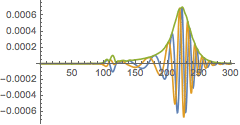
Plot the phase of the complex waveform
In[13]:=
![]()
Out[13]=
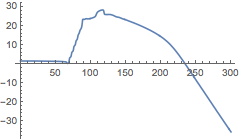
and plot the frequency
In[14]:=
![]()
Out[14]=
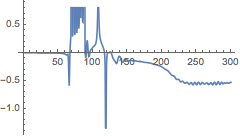
One frequently would like to know how many gravitational wave cycles are present in a waveform as a measure of its length. The WaveformCycles function does so by counting the number of oscillations from a prescribed time up to the peak of the amplitude, which is assumed to correspond to the merger. In the short example binary black hole simulation, there are approximately three gravitational wave cycles before the merger.
In[15]:=
![]()
Out[15]=
![]()
It is also possible to obtain this number directly from the simulation, without having to go through the step of reading ![]() explicitly
explicitly
In[16]:=
![]()
Out[16]=
![]()
Manipulating waveforms
Aligning phases
It is often convenient to consider a complex waveform in terms of amplitude and phase rather than real and imaginary parts. When computing the phase, there is a freedom to add multiples of 2π. When compare two different waveforms, it’s possible that different multiples of 2π have been added to each (this usually happens when the data is not smooth and the algorithm to produce a continuous phase in the Phase function makes a different choice for different waveforms). The AlignedPhases function adds multiples of 2π to a set of phases to minimise their difference at a specific time.
In[17]:=

In[21]:=
![]()
Out[21]=

Converting to strain
Waveforms from numerical relativity simulations are typically extracted as the complex scalar ![]() , whereas many analytic and data analysis calculations prefer to work with the strain, h, which is related to
, whereas many analytic and data analysis calculations prefer to work with the strain, h, which is related to ![]() by two time integrals. The function Psi4ToStrain does this conversion using either fixed-frequency or time-domain integration methods.
by two time integrals. The function Psi4ToStrain does this conversion using either fixed-frequency or time-domain integration methods.
Convert ![]() to h using fixed-frequency integration
to h using fixed-frequency integration
In[22]:=
![]()
Convert ![]() to h using time domain integration chosing the two arbitrary integration constants such that the strain is 0 at t=0 and t=280
to h using time domain integration chosing the two arbitrary integration constants such that the strain is 0 at t=0 and t=280
In[24]:=
![]()
Compare the two integration schemes
In[25]:=
![]()
Out[25]=
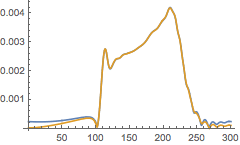
Extrapolation
Waveforms from numerical simulations are normally obtained by extraction of ![]() at finite radius. However, their definition is in terms of
at finite radius. However, their definition is in terms of ![]() at future null infinity. It is therefore common to extract at a sequence of radii and extrapolate to infinite radius. SimulationTools provides some automated functions for performing such an extrapolation.
at future null infinity. It is therefore common to extract at a sequence of radii and extrapolate to infinite radius. SimulationTools provides some automated functions for performing such an extrapolation.
The function ReadRadiallyExtrapolatedPsi4 reads a specific (l,m) mode of ![]() at all radii available in a simulation and produces a waveform which has been extrapolated to infinite radius
at all radii available in a simulation and produces a waveform which has been extrapolated to infinite radius
In[26]:=
![]()
In[27]:=
![]()
Out[27]=
![]()
We can compare this extrapolated waveform to the one extracted at r=100M
In[28]:=
![]()
Out[28]=
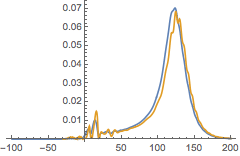
One may also wish to compute the strain at future null infinity. This involves a delicate combination of conversion from ![]() to strain and extrapolation. The function ReadRadiallyExtrapolatedStrain does this in a way that has been found to be generally robust
to strain and extrapolation. The function ReadRadiallyExtrapolatedStrain does this in a way that has been found to be generally robust
In[29]:=
![]()
In[30]:=
![]()
Out[30]=
